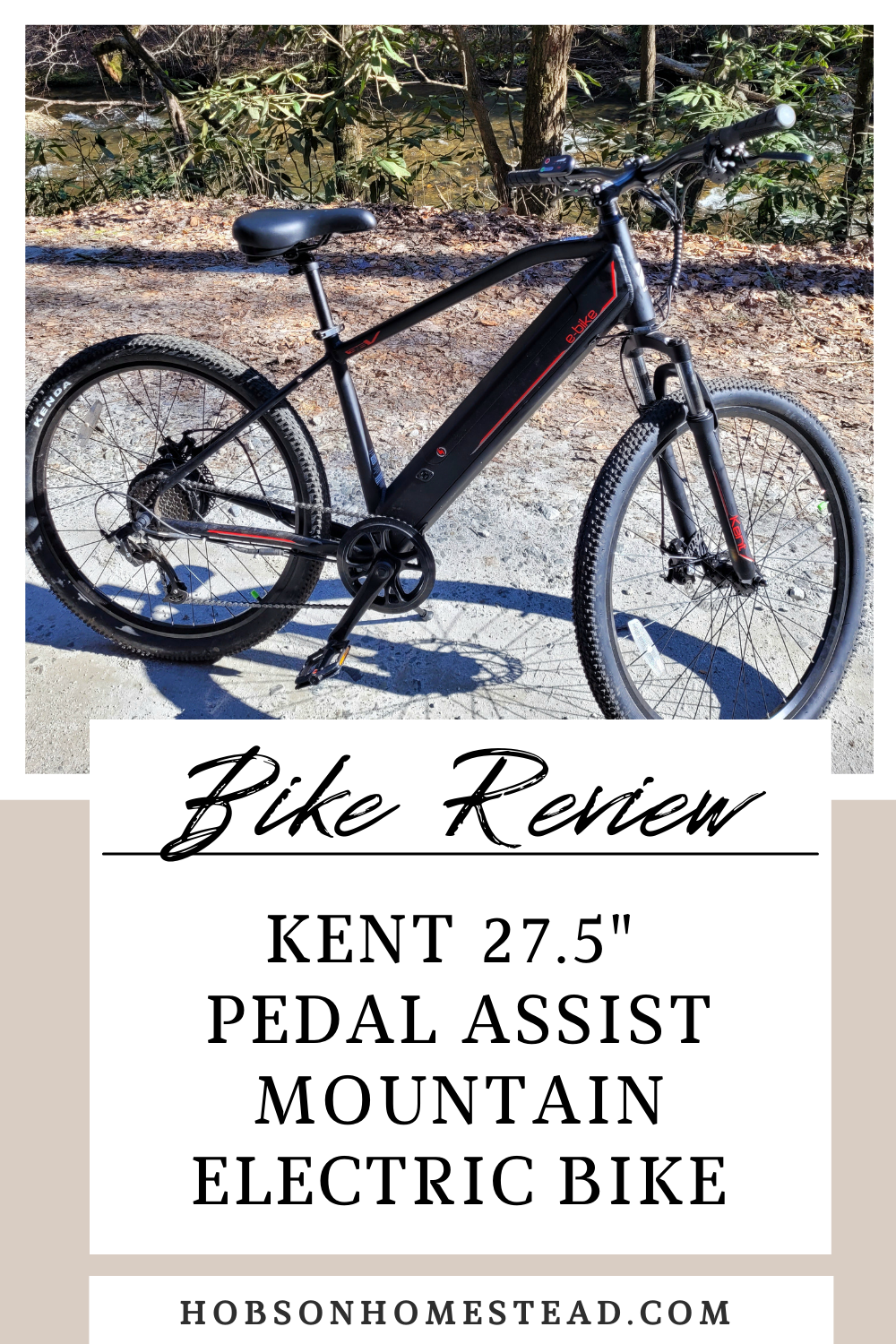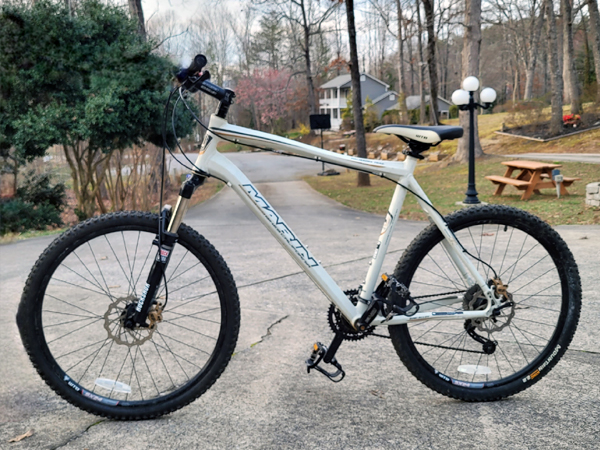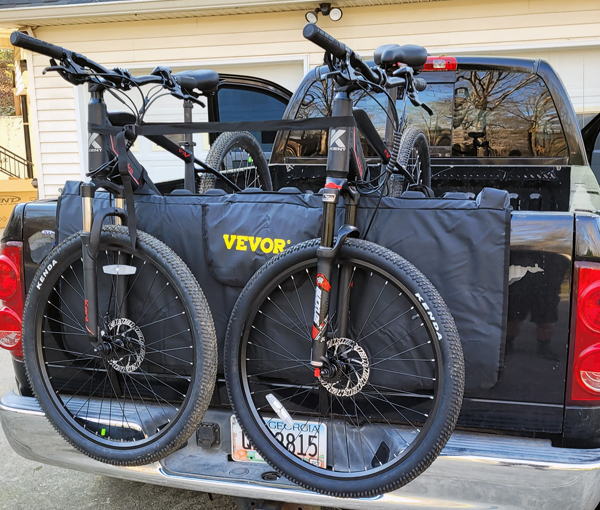It’s true that the Kent 27.5″ electric mountain bike is one of the most budget-friendly options on the market. But before you click “buy now,” be sure you know the pros and cons of this pedal-assist bike.
I started riding mountain bikes when I was a teenager in Augusta, Georgia. When I say mountain bikes, I really mean a 90s Huffy 18-speed I bought from Walmart for $60 without a front suspension. A group of us would carpool out to a lake trail, then ride with reckless abandon, flying over the handlebars multiple times each trip.
Most days, one or more of us would be forced to walk our bikes back to the car due to a broken chain, flat tire or bent wheel. We never wore helmets, of course, because we were teenagers—and teenagers are invincible.
When I moved to Kennesaw, Georgia, to be near my CrossFit gym, I noticed several well-known MTB trails in the area. No longer a teenager, I purchased a custom-made name-brand MTB from a local bike shop and rode the forks off it—literally.
One day while riding a local trail, I took a wrong turn and found myself on a black diamond trail with some huge drop-offs. My front suspension forks took the brunt of the punishment and consequently locked up. For the next couple of years, I continued to ride that bike with the broken forks because standard MTB trails—the greens and blues—don’t require high-end shocks (or apparently any shocks at all).
When I sold the CrossFit gym and moved to Gainesville, Georgia, I lost all of my MTB-riding friends, so my bike went into storage. This year, I introduced my wife Haley to some local beginner singletrack in our new town of Cleveland, Georgia, and she loved it. I installed new front forks on my bike, purchased her a ride, and we started making the weekly trek for a short 30-minute trail excursion.
But after going to the gym and completing several CrossFit workouts each week, the rides became harder and more tedious. Each hill burned out our already fatigued legs and around the 4-mile mark, we’d head back to the car with stiff, cramped muscles.
Then one day, a fellow mountain biker asked if I wanted to ride his bike around the parking lot. I jumped on and took a spin. After a few seconds of strenuous pedaling, the bike suddenly took off with explosive force. It was an e-bike, an electric pedal-assist MTB with a motor that engages when an internal sensor encounters a hill.
I went crazy with excitement. Imagine the possibilities! There are numerous trails in North Georgia with large inclines and several over 15 miles long that we had intentionally avoided. I realized we could skip the gym to train a couple times a week specifically for these longer rides or we could buy e-bikes.
Not wanting to give up my precious gym time, I bought two electric pedal-assist bikes. I chose the Kent Electric Mountain Bike 27.5” from Walmart for a couple of reasons.
First, Walmart allows in-store returns for 90 days. Reviews often mentioned bad batteries, broken bike parts, or other annoying setbacks. Because of this, having a 90-day return policy was extremely important for peace of mind.
Second, at $500 and with free shipping, these bikes are about half the price of every other similar brand.
However, they aren’t without their drawbacks. On my test ride, I chose a 5-mile path at Smithgall Woods State Park that alternated between asphalt and gravel. On the gravelly bits, the e-bike performed well, kicking in enough power to keep the momentum going on the climbs and cutting off on the downhills.
Everything was going great until I encountered a 11%, 6-degree incline. Even while pedaling and in the highest level of assist, the bike barely had enough torque to push me up the hill. At one point, I smelled burning plastic when it hit me that the smell came from the motor, which was burning hot from overuse.
On my second test ride, I tried out the short 3.4-mile singletrack trail that we ride each week. But I ended up popping both the front and rear tire tubes, probably due to my weight stressing the tubes. Popping a tube wouldn’t be so bad, except I had to walk the bike the remainder of the trail.
To combat some of the weight issues and to beef up the ruggedness of my bike, I added higher-end front forks and installed new “run flat” tubes.
For our third eMTB trip, I chose a 16-mile gravel forest service road in nearby Helen, Georgia. The first half was mainly uphill and the bikes performed magnificently. The last 7 miles turned into an obscure, unmaintained dirt/gravel downhill road covered in sticks, pinecones, sharp rocks, and other precarious tire-popping rubbish (along with a wild turkey I almost ran over). Somehow, we made it the whole 16 miles without a flat and with our brains intact.
Our latest trip was the most extreme test yet. There is an old 7.6-mile NORBA Championship course at Unicoi State Park that was abandoned several years ago. Reviews claim this trail is the most wild and most raw ride in the area due to extremely steep ascents and descents, boggy mud, sharp switchbacks, and dangerous washouts.
What a wild ride! We wisely dismounted on the steepest uphills and also walked one suicidal downhill. Otherwise, Haley and I went full speed like teenagers! Other than my one crash in a deep washout, we survived the worst trail in the area and had a blast.
Pros and Cons of the Kent Electric Mountain Bike
Here are some important things I wish I had known before buying the Kent 27.5″ Electric Mountain Bike Pedal Assist:
- Weight limit for the rider is 150 lbs because the manual says the total weight limit for the motor is 200 lbs, INCLUDING the 53 lb bike.
- I weigh 200 lbs and the motor barely pushes me up a hill even on level 3, while I frantically pedal.
- As I am furiously pedaling up the hill on level 3 assist, the motor starts to burn and smoke.
- The size is similar to my two other mtb that are both large-size frames, so a person over 6′ can ride this bike easily (if under the 150 lb weight limit).
- The weight limit matters because a 350w motor will burn out and break if pushed too hard by excessive weight.
- This is why all the newer model electric bikes from China are 500w, 750w and now 1000w. If you read the reviews on older 350w bikes, the most common complaint is that the motor quits after 4 months from burnout.
- The front suspension shocks are basement-level springs and bottom out on small roots, but again at 200 lbs the springs are not made for my weight.
Anyone under 160 lbs will LOVE this bike—my wife (5’7 and 130 lbs) is one of those people who is a perfect fit for this e-bike. With a few upgrades, you can confidently ride almost any terrain and the pedal assist adds just enough boost to get you up the annoyingly difficult uphills without making you feel like you’re riding an overpowered dirt bike.
WARNING: Our second bike’s battery dies after a couple of hours of riding while our first bike’s battery remains fully charged. I hoped to switch out this bad battery with a new battery and filed a claim with Kent. We are still working to find a mutually agreeable resolution.








